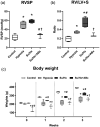Gut microbiota modification suppresses the development of pulmonary arterial hypertension in an SU5416/hypoxia rat model
- PMID: 32922743
- PMCID: PMC7457673
- DOI: 10.1177/2045894020929147
Gut microbiota modification suppresses the development of pulmonary arterial hypertension in an SU5416/hypoxia rat model
Abstract
The pathogenesis of pulmonary arterial hypertension is closely associated with dysregulated inflammation. Recently, abnormal alterations in gut microbiome composition and function were reported in a pulmonary arterial hypertension experimental animal model. However, it remains unclear whether these alterations are a result or the cause of pulmonary arterial hypertension. The purpose of this study was to investigate whether alterations in the gut microbiome affected the hemodynamics in SU5416/hypoxia rats. We used the SU5416/hypoxia rat model in our study. SU5416/hypoxia rats were treated with a single SU5416 injection (30 mg/kg) and a three-week hypoxia exposure (10% O2). Three SU5416/hypoxia rats were treated with a combination of four antibiotics (SU5416/hypoxia + ABx group) for four weeks. Another group was exposed to hypoxia (10% O2) without the SU5416 treatment, and control rats received no treatment. Fecal samples were collected from each animal, and the gut microbiota composition was analyzed by 16S rRNA sequencing. The antibiotic treatment significantly suppressed the vascular remodeling, right ventricular hypertrophy, and increase in the right ventricular systolic pressure in SU5416/hypoxia rats. 16S rRNA sequencing analysis revealed gut microbiota modification in SU5416/hypoxia + ABx group. The Firmicutes-to-Bacteroidetes ratio in SU5416/hypoxia rats was significantly higher than that in control and hypoxia rats. Compared with the control microbiota, 14 bacterial genera, including Bacteroides and Akkermansia, increased, whereas seven bacteria, including Rothia and Prevotellaceae, decreased in abundance in SU5416/hypoxia rats. Antibiotic-induced modification of the gut microbiota suppresses the development of pulmonary arterial hypertension. Dysbiosis may play a causal role in the development and progression of pulmonary arterial hypertension.
Keywords: dysbiosis; inflammation; pathogenesis; pulmonary hypertension experimental; vascular remodeling.
© The Author(s) 2020.
Figures





References
-
- Fuster V, Steele PM, Edwards WD, et al. Primary pulmonary hypertension: natural history and the importance of thrombosis. Circulation 1984; 70: 580–587. - PubMed
-
- Humbert M, Sitbon O, Yaici A, et al. Survival in incident and prevalent cohorts of patients with pulmonary arterial hypertension. Eur Respir J 2010; 36: 549–555. - PubMed
-
- Farber HW, Miller DP, Poms AD, et al. Five-year outcomes of patients enrolled in the REVEAL Registry. Chest 2015; 148: 1043–1054. - PubMed
-
- Galiè N, Humbert M, Vachiery J-L, et al. 2015 ESC/ERS guidelines for the diagnosis and treatment of pulmonary hypertension: the Joint Task Force for the Diagnosis and Treatment of Pulmonary Hypertension of the European Society of Cardiology (ESC) and the European Respiratory Society (ERS) endorsed by: Association for European Paediatric and Congenital Cardiology (AEPC), International Society for Heart and Lung Transplantation (ISHLT). Eur Heart J 2015; 37: 67–119. - PubMed
LinkOut - more resources
Full Text Sources
Other Literature Sources

